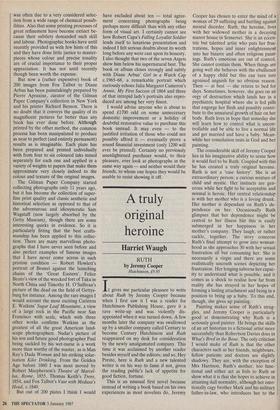A truly original heroine
Harriet Waugh
RUTH by Jeremy Cooper
Hutchinson, £9.95
It gives me particular pleasure to write about Ruth by Jeremy Cooper because when I first saw it I was a reader for Hutchinson Publishing House, gave it a rave write-up and was violently dis- appointed when it was turned down. A few months later the company was swallowed up by a smaller company called Century to become Century Hutchinson and Ruth reappeared on my desk for consideration by the newly amalgamated company. This time it was acclaimed by another reader besides myself and the editors; and so, Hey Presto, here is Ruth and a new talented writer is on his way to fame if not, given the reading public's lack of appetite for good fiction, fortune.
This is an unusual first novel because instead of writing a book based on his own experiences as most novelists do, Jeremy Cooper has chosen to enter the mind of a woman of 29 suffering and battling against mental disorder. Ruth, the heroine, lives with her widowed mother in a decaying manor house in Somerset. She is an eccen- tric but talented artist who puts her frus- trations, hopes and inner enlightenment into her bizarre and often religious paint- ings. Ruth's emotions are out of control. She cannot contain them. When things are going well she behaves with the ebullience of a happy child but this can turn into agonised anguish for no obvious reason. Then — at best — she retires to bed for days. Sometimes, however, she goes on an orgy of destruction which lands her in a psychiatric hospital where she is fed pills that engorge her flesh and possibly contri- bute to the unnatural growth of hair on her body. Ruth lives in hope that someday she will learn how to control what is uncon- trollable and be able to live a normal life and get married and have a baby. Mean- while her consolation rests in God and her painting.
The considerable skill of Jeremy Cooper lies in his imaginative ability to sense how it would feel to be Ruth. Coupled with this he has created a truly original heroine. Ruth is not a 'case history'. She is an extraordinary person; a curious mixture of child and mystic. Her instincts are gen- erous while her fight to be acceptable and normal is heroic. Her central relationship is with her mother who is a loving drunk. Her mother is dependant on Ruth's de- pendence on her. Occasionally Ruth glimpses that her dependence might be central to her illness blit this is easily submerged in her happiness in her mother's company. They laugh, or rather cackle, together. The story concerns Ruth's final attempt to grow into woman- hood as she approaches 30 with her sexual frustration all but consuming her. She is necessarily a virgin and there are some realistically uncouth scenes depicting her frustration. Her longing suborns her capac- ity to understand what is possible, and it comes as a shock to realise how far from reality she has strayed in her hopes of forming a lasting attachment and being in a position to bring up a baby. To this end, though, she gives up painting.
Painting makes sense of Ruth's strug- gles, and Jeremy Cooper is particularly good at demonstrating why Ruth is a seriously good painter. He brings the skills of. an art historian to a fictional artist more successfully than Robertson Davies does in What's Bred in the Bone. The only criticism I would make of Ruth is that the other characters such as her friends, neighbours, fellow patients and doctors are slightly shadowy. They are, with the exception of Mrs Harrison, Ruth's mother, too func- tional and either act as foils to Ruth or show what it is that she hopes to achieve in attaining dull normality, although her emo- tionally cagy brother Mark and his military father-in-law, who introduces her to the limited pleasures of country life, are more strongly drawn. But, all in all, I think it is an imaginative tour-de-force for a man to absorb so completely and sympathetically the troubled world of such a strange heroine as Ruth.











































 Previous page
Previous page